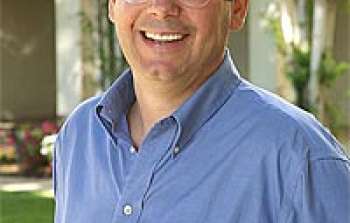sci08005 — Announcement
Questions for David Silva, Incoming NOAO Director
March 31, 2008
David Silva was named the new NOAO Director in an announcement made by AURA on March 25. He will begin a five-year term on July 7. As NOAO Director, Silva will be responsible for all of NOAO operations and development. Silva brings to the position a long history of service to NOAO as well as strategic leadership and management experience. He is currently the Observatory Scientist for the Thirty Meter Telescope project. Prior to that, he was responsible for data management and user support at the European Southern Observatory. From 1991 to 1996, Silva was a member of the NOAO scientific staff. He served as project manager during the commissioning of the WIYN 3.5-meter telescope and as a staff astronomer in the US Gemini Program. Silva received his PhD from the University of Michigan in 1991 and a bachelor of sciences degree from the University of Arizona. Currents talked with Silva about his current thoughts and upcoming plans for NOAO.
Currents: What do you see as the major opportunities open to NOAO in the next few years?
Silva: I see several opportunities for NOAO to enhance the science capabilities that it provides to the US astronomical community.
- We have a mandate from the Senior Review to revitalize the core science infrastructure at KPNO and CTIO, with an emphasis on new spectrographs for 4-meter-class telescopes.
- There is an emerging consensus, most recently articulated in the report from the Astronomy and Astrophysics Advisory Committee (AAAC), that both scientific and budgetary benefits could be gained from developing a much closer linkage between Gemini and NOAO.
- We also have the opportunity to enhance the national system of science capabilities, especially through instrument deployment initiatives such as TSIP and by assuring good user support at all system facilities during open access time.
- Over the longer term, we look forward to the era of LSST and GSMT. Currently, NOAO has a significant role in LSST through its work on the telescope and the site and in providing community access to the planning process via the LSST science teams. The NOAO GSMT Program Office is the current focus for the discussion of the US Extremely Large Telescope (ELT) strategy, which may evolve over time into NOAO involvement in one or more ELT partnerships. I believe NOAO can have a strong operational role in both LSST and GSMT, although the exact details will depend on the composition of the final partnerships.
Currents: What are the major challenges facing NOAO?
Silva: Continued National Science Foundation (NSF) support is needed to support the expanded and revitalized nighttime program that I described. Naturally, the NSF cannot provide such support unless they receive adequate funding from the federal government. Hence, like all other federally-supported science facilities and projects, NOAO is at the mercy of the annual federal budget process. That is our major uncertainty. We also have the challenge of maintaining and extending a cross-community consensus for a strong national observatory system that enables excellent science at both public and private observatories. Without such a consensus, I believe the entire US nighttime program, public and private, will suffer. I am optimistic that NOAO can work with the entire community to overcome these challenges in the years ahead.
Currents: What is your current strategy for capitalizing on the opportunities and meeting the challenges?
Silva: Looking outward, it is important to engage continuously with the various high-level committees that represent the interests of the US astrophysical community. In this regard, the recommendations of the Decadal Survey will be key to the future of NOAO. Looking inward, it is important to do a finite number of things well, rather than many things poorly. During my first three to six months, I intend to work with the NOAO scientific staff, as well as the AURA Observatory Council, NSF Program Review Panel, and NOAO Users’ Committee, to refine our short-term and long-term goals and then push to achieve those goals as quickly as possible. We will be guided by the reports of high-level committees such as the AAAC and also by community-based committees such as ReSTAR (Renewing Small Telescopes for Astronomical Research) and the follow-on committee that will discuss larger aperture telescopes. I will present the outcome of those discussions in a future issue of Currents and at the January 2009 AAS meeting.
Currents: What role do you see for the community in this process?
Silva: NOAO serves the community, not vice versa. In addition to our on-going dialogue with the various community-based committees I mentioned above, I want to enable direct communication with a larger cross-section of the NOAO community. One approach that I am considering is having regular science workshops modeled on the Keck Science Meetings. Such a workshop would include opportunities not only for the NOAO community to present research highlights, but also for the community to engage in structured dialogues with NOAO senior managers (including myself) about strategic issues. It would provide a way to tap directly into the science interests and scientific excitement in the NOAO community to influence the capabilities and services that we deliver.
Contacts
David Silva
NOAO Director
NOAO Press Release 08-04.
About the Announcement
| Id: |
ID
sci08005
|
